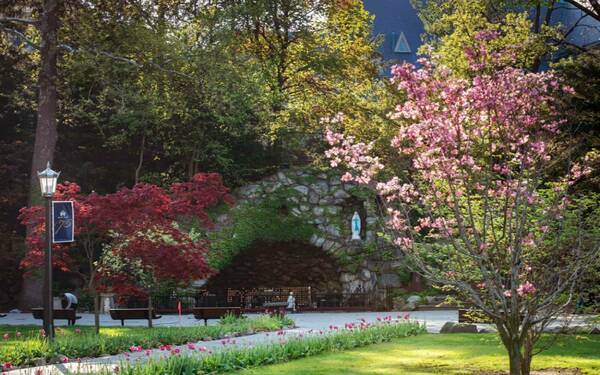

With a crew of approximately 45 employees strong, Landscape Services maintains more than 1,250 acres of campus property by using several sustainable practices and plantings. While they do spend a fair amount of time keeping the lawns treated and trimmed, they also have the responsibility of landscaping new and re-landscaping existing buildings on campus, all while keeping sustainability in mind.
Several of those landscape projects on campus incorporate native plantings. The landscaping around the Compton Family Ice Arena and the new Harris Family Track & Field is a beautiful example of native plant landscaping. Native plantings adapt to the local climate, soil types, and animals better than non-native plantings. Native plants have also developed a natural defense against diseases and pests, which helps reduce maintenance costs and requires less pesticide use. The surrounding landscape of Stinson-Remick also contains all-native plants and supports a rain garden that collects storm water runoff and allows it to percolate slowly into the ground. The Geddes Hall landscape design includes a high-tech irrigation system, reducing irrigation water consumption by 58 percent.
The roof areas on the Morris Inn and the new Duncan, O’Neill, and Corbett Halls include vegetated green roofs. This type of roof system provides several sustainability benefits, including increased building energy efficiency and improved air quality. A major benefit of green roofs is their ability to absorb storm water and release it slowly over a period of several hours. Green roof systems have been shown to retain 60-100% of the storm water they receive.
The recently renovated Walsh Hall dorm received a new landscape exterior and will be ready for students to return this fall, while St. Michael’s Laundry was given a total makeover to its exterior this summer. The remaining construction projects (North Dining Hall, Hesburgh Library, and Jenkins/Nanovic Hall) will be receiving their finishing touches in time for the fall semester.
In 2016, the Alumni Class of 1976 planted a butterfly garden on the corner of St. Mary’s Road and Holy Cross Drive. The garden, situated near the Grotto has provided an additional area for pollinators on campus and is a wonderful welcome of color for visitors and campus community members.
The garden consists of several varieties that naturally attract butterflies, including Purple Coneflowers, Tickseed ‘Moonbeam’, Sunshine Blue Bluebeard, and Blue Chip Butterfly Bushes. The butterflies also provide a natural pest-control and support a range of other necessary ecosystem organisms from birds to microbes.
So the next time you’re on campus, make sure to stop and look around – you will quickly see why out of 100 Most Beautiful College Campuses in America, Notre Dame ranks No. 5, and of the 50 Most Amazing College Campuses of 2017, Notre Dame is ranked No. 16.
Originally published by at green.nd.edu on July 21, 2017.